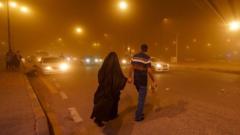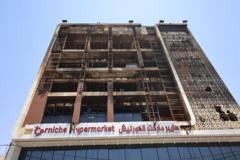Increased frequency of sandstorms, attributed to climate change, poses a threat to public health in Iraq.
Facing Health Crisis: Iraq's Recent Sandstorm Causes Respiratory Illness Surge

Facing Health Crisis: Iraq's Recent Sandstorm Causes Respiratory Illness Surge
Severe dust storm blankets Southern Iraq, exacerbating health issues for thousands.
The severe sandstorm that swept through central and southern Iraq has led to over 1,000 individuals suffering from respiratory issues, prompting urgent medical responses from local healthcare services. Health officials report that approximately 700 cases of suffocation were documented in Muthanna province alone, with online footage showing towns engulfed in a dense orange haze.
The sandstorm not only affected air quality but also caused major disruptions, including power outages and the cancellation of flights in several areas. As dust storms are becoming increasingly common in Iraq—attributed to climate change—citizens have been urged to wear face masks as protection against the hazardous dust concentrations in the air.
Local health facilities have struggled to manage the surge of patients: over 250 were admitted in Najaf province, while 322 individuals, including children, received treatment in Diwaniyah province. Dhi Qar and Basra provinces recorded at least 530 incidents of breathing difficulties among residents.
The sight of reduced visibility—down to less than one kilometer—was exacerbated by the widespread dust cloud that blanketed the region, leading to airport closures in Najaf and Basra as safety precautions. Despite the troubling conditions, forecasts indicate that weather patterns should start to improve by Tuesday morning.
Iraq is classified as one of the five nations most vulnerable to the impacts of climate change, facing an increasing frequency of extreme weather events like dust storms alongside other challenges such as heatwaves and water shortages. Historical events reveal the ongoing threat: a previous sandstorm in 2022 resulted in one fatality and over 5,000 respiratory-related medical cases. Moving forward, Iraq's environment ministry has warned residents to prepare for more frequent "dust days" ahead.
The sandstorm not only affected air quality but also caused major disruptions, including power outages and the cancellation of flights in several areas. As dust storms are becoming increasingly common in Iraq—attributed to climate change—citizens have been urged to wear face masks as protection against the hazardous dust concentrations in the air.
Local health facilities have struggled to manage the surge of patients: over 250 were admitted in Najaf province, while 322 individuals, including children, received treatment in Diwaniyah province. Dhi Qar and Basra provinces recorded at least 530 incidents of breathing difficulties among residents.
The sight of reduced visibility—down to less than one kilometer—was exacerbated by the widespread dust cloud that blanketed the region, leading to airport closures in Najaf and Basra as safety precautions. Despite the troubling conditions, forecasts indicate that weather patterns should start to improve by Tuesday morning.
Iraq is classified as one of the five nations most vulnerable to the impacts of climate change, facing an increasing frequency of extreme weather events like dust storms alongside other challenges such as heatwaves and water shortages. Historical events reveal the ongoing threat: a previous sandstorm in 2022 resulted in one fatality and over 5,000 respiratory-related medical cases. Moving forward, Iraq's environment ministry has warned residents to prepare for more frequent "dust days" ahead.




















